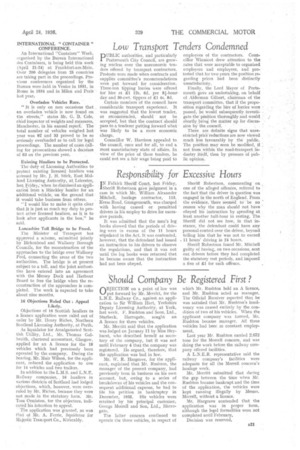Should Company Be Registered First ?
Page 35

Page 36

If you've noticed an error in this article please click here to report it so we can fix it.
OBJECTION on a point of law was put forward by Mr. Merritt, for the L.N.E. Railway Co., against an application to Sir William Hart, Yorkshire Deputy Licensing Authority,at York, last week. F. Rushton and Sons, Ltd., Starbeck, Harrogate, sought an A licence for three vehicles.
Mr. Merritt said that the application was lodged on January 11 by Miss Heyburst, who described herself as secretary of the company, but it was not until February 4 that the company was registered. he argued, therefore, that the application was bad in law.
Mr. W. R. Hargrave, for the applicant, explained that Mr. Rushton, the manager of the present company, had previously been in business on his own account, but, owing to a series of breakdowns of his vehicles and the consequent additional expense, be had to file his petition in bankruptcy in December, 1935. His vehicles were retained by his principal customer, George Morrell and Son, Ltd,, Harmgate.
The latter concern continued to operate the three vehicles, in respect of which Mr. Rushton held an A licence, and Mr. Rushton acted as manager. The Official Receiver reported that he was satisfied that Mr. Rushton's insolvency was caused entirely by the condition of two of his vehicles. When the applicant company was formed, Mr. Rushton became manager. All three vehicles had been in constant employment.
Last year Mr. Rushton carried 2,672 tons for the Morrell concern, and was doing the work before the railway company offered facilities: A L.N.E.R. representative said the railway company's facilities were adequate for MI the Morrell concern's haulage work,
Mr. Merritt submitted that during the gap between the time when Mr. Rushton became bankrupt and the time of the application, the vehicles were kept running illegally by Messrs. Morrell, without a licence.
Mr. Hargrave contended that the application' was in proper form, although the legal formalities were not completed until February.
Decision was reserved.
Furthermore, there was nothing in Section 15 to limit the arguments put before the Licensing Authority, and the Tribunal had been given the widest possible powers in this respect.
The Tribunal found that it had power to strike out grounds of appeal in certain circumstances. In this instance, the appellants were entitled to present a case on allegations that the Deputy Licensing Authority was wrong. The application was dismissed.
Some Revenue and Expenditure Figures.
During 1935-36 the Road Fund expenditure (self-balancing) provided for in the Budget was £26,230,000. The estimate for the year 1936-37 is £26,500,000, being an increase of £270,000. The receipts last year (1935-36) were £25,77:1,000, and the estimated amount for the current year, on the basis of existing taxation, is £26,500,000—an increase of £725,000.
The Exchequer share of the motorvehicle duties for 1936-37 will be 25,000,000. MORE MILLIONS FROM ROADVEHICLE LICENCES.
The gross amount received in payment for road-vehicle licences issued during the three months ended February 29, 1936, was £20,018,420, cornpared with £18,803,957 in the corresponding period of last year. The average receipt in respect of a whole-year license was £27 14s. 6d. for internalcombustion and steam goods vehicles, £24 18s. for electric goods vehicles and £52 Os. 6d. for hackneys.
At the end of February last the number of licences current in respect of goods vehicles was 425,010 and for hackneys 72,473, the comparable returns for last year being 403,161 and 73,011.
In the advertisement of Dennis Brothers, Ltd., in our issue dated April 3, it was stated that the body of a laundry boxvan which was illustrated was a product of the Dennis concern, whereas, in fact, it was manufactured by Messrs. D. Tomlin and Sons, 22, Bellingdon Road, Chesham.




























































































